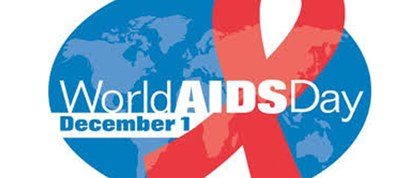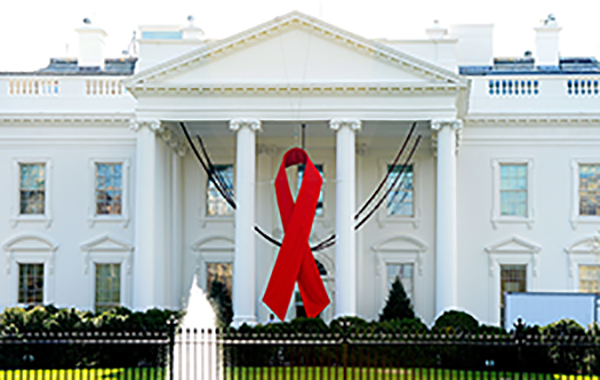
The Fight Against Global AIDS
Dear Colleagues and Students,
Today is World AIDS Day and according to UNAIDS, since the start of the epidemic over 76 million people have become infected with HIV, and 35 million have lost their lives to it – a million in just last year. In 2016, nearly 37 million people globally were living with HIV, and nearly 2 million became newly infected. The good news is that as of June 2017, more than 20 million people were accessing antiretroviral therapy.
It’s now been over 35 years since this mysterious disease began to take the lives of gay men, IV drug users, hemophiliacs and others. I remember the beginning of the AIDS epidemic as if it were yesterday. The disease had no name at first -- other than the range of opportunistic diseases it was inflicting on unsuspecting young bodies -- and it had no known etiology. But it appeared to be related to sexual behavior or a shared risk factor among gay men. Soon it was known as GRID (Gay-Related Immune Disease). As a health care professional just beginning to study public health in earnest, it was my first major epidemic and, in fact, it turned out to be the “World Series” of public health.
Mobilization was slow ... very slow. Gay Men’s Health Crisis was born; academic medical centers and government were cajoled to get cracking, and they were justly accused of lacking the concern everyone would have demonstrated were the mystery epidemic occurring among straight people and the children of middle class white people. Act Up was created by grass roots activists as just one group to press for action.
Cloistered in the comforting elite locale of the Columbia College of Physicians and Surgeons, I sadly had a ringside seat for the various ways one crucial organization slowly stepped up.
I was on the central health sciences management group, known then as “Group 6,” when a letter was received from a group of desperate gay men begging for help in solving this mystery disease. By then, the US Centers for Disease Control and Prevention was slowly mobilizing, and had tasked shoe-leather epidemiologists to troll the bars and bathhouses of New York City and San Francisco in search of answers.
Upon reading the letter a senior member of the team said, “File that in the circular file” -- a euphemism for the trash can. I remember feeling horrified and arguing with the group, saying I had sick friends in the Village and on Fire Island. They said it was the government’s problem and that our research apparatus could not "turn on a dime" and dive into different lines of research. Indeed, on that score, they were correct that no funding for extramural research had yet been released. One silent member of the group was a single man, a very senior member of the management team who was losing weight rapidly. He thanked me under his breath as we left the meeting, and he was dead a year later.
Soon, Dr. John Martin, a public health faculty member, received the first Columbia grant to aggregate a cohort of gay men and follow them over time. More research rapidly followed and in a few years -- an eternity given the pace of this burgeoning epidemic -- all major health science centers in New York City were funded and seeking breakthroughs in treatment, prevention and vaccine development. NYU opened a P3 containment facility to handle live virus and contribute to debates about the cause, transmission, incubation period and control of AIDS. In that period—at the beginning of the epidemic and absent a test for the presence of the illness — debates broke out and changed shape over time. By 1985, four long years into the epidemic, a test was developed.
But we had a diagnostic tool without a treatment, which raised a broad range of new social and political issues. Bold tactics had been employed to prevent HIV infection, including youth condom access, explicit public education, and clean needle access. Surgeon General C. Everett Koop became an explicit education champion when he, via a mailing that went to all American households, advised parents to start discussing the virus with children as young as age four.
Debates included discussion of whether curbing transmission could be accomplished through mandatory testing or mandatory isolation of the infected. The latter policy was implemented by Cuba and discredited initially (see my paper with Dr. Ronald Bayer in the New England Journal of Medicine, “Controlling AIDS in Cuba,” here). However, this policy is now being subjected to serious revisionist history, with many asserting that Cuba truncated the epidemic by isolating in special facilities all who tested positive. In this revisionist analysis there is no mention of the extraordinarily inappropriate step Cuba took to take freedom away from hundreds of people because of something that MIGHT happen behaviorally. Imagine the ramifications for our society today, if this had caught on for AIDS and other behaviorally-driven epidemics.
We wrote grants day and night to keep the flow of pre- and post- Ryan White Care Act funds flowing into NYC to respond to the growing emergency. Doctors and nurses worked extraordinary hours, and those at the vanguard of experimental treatments were understandably stalked by desperate patients and their loved ones. People seriously burned out, and I was one of them. Twenty years into the epidemic I moved on. The only major breakthrough I had seen in that time was the success of AZT in sharply reducing perinatal transmission of HIV. I remember my glee the day the data advisory board shipment arrived in the mail, signaling the end of the clinical trial and thus its success. Soon after, when I left Columbia to lead a tobacco-focused foundation in Washington, DC, antiretroviral therapy was demonstrated to work fairly quickly, and AIDS began to look more like a chronic disease for those with access to care.
I have countless anecdotes from those 20 years -- some funny, some poignant, and some sad in the extreme. Two stand out.
I led the Northern Manhattan Women and Children HRSA-funded demonstration project, and one morning I took a small group on a tour of the five member hospitals in northern Manhattan. It was the height of the pediatric AIDS epidemic, and we met over 100 children with AIDS at these five hospitals in a few short hours. When we were finished, I broke away from the crowd and sat on a curb near Metropolitan Hospital, and I simply cried. Someone asked if they could help. "No," I said but they persisted. “What’s wrong?" "Everything," I replied. Just then a fire truck pulled up and raised its ladder up to the hospital’s pediatric ward. The staff had arranged for a young boy’s wish to come true – he wanted to meet some firemen. They climbed up and spoke with him, and I stopped crying.
On another occasion, while on a cross-country trip, a young woman sitting next to me on the plane noticed I was reading documents related to AIDS. After reading over my shoulder for a while, she said, "My brother just died of AIDS." I told her how sorry I was. She and her family were from North Carolina, and she recounted her upbringing in a racist and homophobic home. Her brother was gay, and that fact had been known only to her until he reached the end stage of AIDS. Despite their predilections, his parents welcomed him home, and he died soon after in his father's arms. But word had spread in their part of town that someone in the house had "it." When her father called funeral homes to come pick up the body, he got a rude awakening ... no one wanted his business. Finally, he called "across the tracks," as she put it, and an African-American funeral director came and gently cared for her brother, and indeed her whole family. This incident was an epiphany for her family, and she cried as she described to me how her parents would never be the same.

Fast forward to today, where the signature red ribbon now hangs at the White House. But there are also ominous red flags that “the Trump administration is proposing a reduction in funding and a shift in strategy in the fight against global AIDS that together would increase infections, cost lives and threaten the extraordinary progress of the past 15 years,” (Washington Post).
If we continue this fight, this is one public health battle that is winnable, and we’re closer than ever to ending it. But like those parents in North Carolina, none of us who have fought or lost loved ones to HIV AIDS will ever be the same.

Cheryl G. Healton, DrPH
Dean